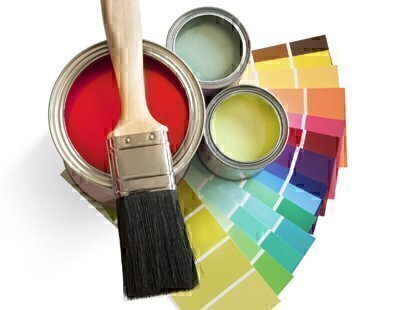How to Choose Paint
Last updated June 2021
Eggshell. Latex. Semi-gloss. Oil. There are so many vocabulary words surrounding types of house paint, you might think you need a dictionary. Consider this our primer on figuring out what’s in the can and where to use it.
Below are some key definitions and important points to consider when you select paint.
 Interior vs. Exterior
Interior vs. Exterior
Interior and exterior paints are not interchangeable; they’re formulated differently. Generally, interior paints are made to dry harder than exterior paints, which makes them less flexible but more scrubbable. Outside, flexibility helps paint withstand extremes of weather. Also, additives used mostly in exterior paint improve resistance to mold formation and fading in sunlight.
Repainting a surface covered in old oil-based paint requires special prep work; otherwise, the new latex paint layer will flake and lift, sometimes within hours. Try a test-patch application of oil-based primer, let it dry at least 24 hours, then test a finish coat of paint.
If you’re not sure what’s on the wall, clean and dry a sample spot, and rub the area with a swab soaked in denatured alcohol. If the paint comes off, it’s water-based and you can repaint it without applying primer; if it doesn’t, it’s oil-based and you have more work to do.
Finishes
Flatter finishes conceal more defects, while glossier finishes highlight them. But flat finishes tend to look best on walls and ceilings, while glossier finishes look best on woodwork and are easier to clean. It sounds simple, but manufacturers use a bewildering array of words to describe the range. Although the best way to decide is to test a sample, here’s a rundown of the differences:
- Flat or matte—reflects the least amount of light and gives a rich finish to deep colors.
- Satin, silk, eggshell, or low-luster—has some shine and usually means the paint is more washable than flat/matte.
- Semi-gloss—sometimes used on walls in kitchens and baths, but more often on woodwork and trim.
- Gloss or high-gloss—highly reflective, can be glaring on trim next to a flat wall paint and nearly blinding in a brightly lit kitchen.
Coverage
A figure for the square footage covered per gallon appears on the paint can, but it’s generally overly optimistic. Multiple calculators on the web can help you figure out how much to buy. In general, you’ll need one gallon per 300 to 400 square feet of surface.
Color
You can pick up samples from stores, and on the internet you’ll find online design programs (many from paint manufacturers) with palettes displaying millions of possible combinations. The trick is to translate the color you have in mind to the paint that finally appears on the wall. Swatches can help, as long as you try them in different light on different walls. But for large projects that can require several gallons, painting a small test area or purchasing a newfangled stick-on sample (like a supersized paint Post-it) is the best option.
Click here for more paint-picking tips.
Paint Ratings
Consumer Reports regularly conducts accelerated aging and exposure tests on paints from many manufacturers in its unbiased ratings. Some of its top-rated products performed better than more expensive paints and cost $10 to $20 less per gallon.


